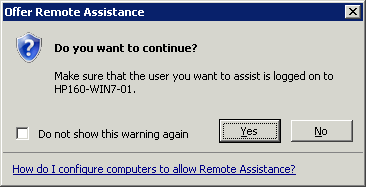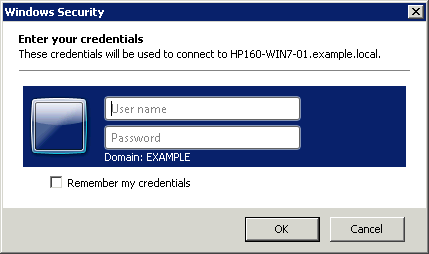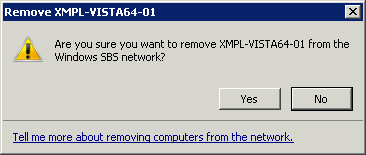2. Remotely Managing Computers
Network Administrators can remotely manage a computer from the
Windows SBS Console, either offering remote assistance to the currently logged-on user or
directly connecting to the computer over Remote Desktop.
2.1. Offering Remote Assistance
One way of managing computers remotely is by directly
helping users to perform their tasks. Remote Assistance gives the Network Administrator a
way to share the session of a user on a Windows XP or Windows
Vista computer. It is not available on down-level Windows
computers such as Windows 2000 Professional, or on non-Windows
computers.
When you share a session using Remote Assistance, both the
user and the Network Administrator see the same thing and both can
interact with the session using both keyboard and mouse.
To offer Remote Assistance, follow these steps:
Open the Windows SBS Console if it isn’t already
open.
Click the Network button, and then select the computer
you want to offer Remote Assistance to.
Click Offer Remote Assistance from the Tasks pane. If you
haven’t disabled the warning, you’ll see a reminder that you
need to make sure the user you want to help is logged on, as
shown in Figure 4.

Click Yes. The user logged on to the computer you’re
offering assistance to is prompted to let you share her
session, as shown in Figure 5.

If the user accepts the offer by clicking Yes, her
desktop will be shared back to the SBS server console, and
both screens will have the Remote Assistance toolbar
displayed, as shown in Figure 6.

When the Remote Assistance session has accomplished its
task, either user can click the Disconnect button in the
Remote Assistance toolbar to end the session.
2.2. Connect Remotely
Remote management tasks that can’t be easily accomplished in
a Remote Assistance session, or that need to be performed when no
user is logged on to the remote computer, often needed to be
performed by physically going to the computer and logging on with
the administrator’s account. A major nuisance, certainly. With the
inclusion of Remote Desktop in business-focused editions of
Windows, administrators have an alternative—a Remote Desktop
session. When you join a computer to the SBS domain using
http://connect, one of the settings that is
propagated to the new client is to enable Remote Desktop on the
computer.
Although it’s easy enough to directly connect to a remote
computer using either the Remote Desktop link in the All programs,
Accessories folder of the Start Menu or from the command line
using mstsc.exe, the Windows SBS Console gives you direct
access from the console. Just highlight the computer in the
Computers page of the Windows SBS Console and click Connect To A
Computer Using Terminal Services in the Tasks pane. You’ll see a
prompt for the connection credentials to use, as shown in Figure 7, and then a
full-screen Remote Desktop session opens.

If there is an active session on the remote computer, you’ll
get a warning that the other user will be disconnected from the
session. Unlike with Remote Assistance, you can’t share a Remote
Desktop session to a client computer. (The exception to this is
that Remote Desktop connections to Terminal Server sessions can be
shared, if necessary.)
The only real problem with using the Windows SBS Console to
initiate a Remote Desktop session is that it will always be a
full-screen session. That’s fine for some things, but it can be a
nuisance if you’re trying to do the same task on multiple client
computers. In that event, we like to use the command line:
mstsc /v:<computername> /h:<height> /w:<width>
So, to open three Remote Desktop sessions, each with a resolution of 1024x768, to the
computers hp160-win7-01, xmpl-vista64-01, and hp160-v32-03, a
simple PowerShell command line will get the job done:
PSH> $RDP_Array = "hp160-win7-01", "xmpl-vista64-01", "hp160-v32-03"
PSH> foreach ($computer in $RDP_Array) {mstsc /v:$computer /h:768 /w:1024}
Note:
You can easily use a combination of hard file links and
the PowerShell code just shown to create a smart script that
lets you log in to a machine simply by entering its name from
the PowerShell command line. My current version has two dozen
hard links to the same PowerShell script.
3. Removing Computers from the Network
You should remove computers from the network only if the
computers are being decommissioned. When you remove a computer from
the network, you make any SBS user accounts on the computer
unavailable, and even if you later rejoin the computer to your SBS
domain, new user profiles will be created and the old ones will be
unavailable. If you do have to temporarily have a user use a
computer without being part of the domain, you can usually just
create a local user account on the computer and have the user log on
to that account.
If circumstances require you to remove a computer from the
domain and you want to save some of the settings for an existing
account, use the Windows Easy Transfer (WET) Wizard, or with Windows XP, the Files And
Settings Transfer Wizard. This won’t save everything, but it will
save many of the current user’s settings.
To remove a computer from the SBS domain, follow these
steps:
Open the Windows SBS Console if it isn’t already
open.
Click the Network button, and then select the computer you
want to remove from the SBS domain.
Click Remove Computername in the
Tasks pane.
When prompted, as shown in Figure 8, click Yes to
remove the computer.
